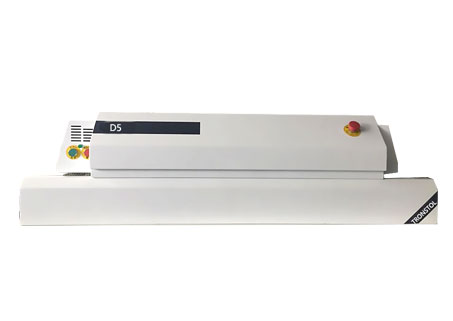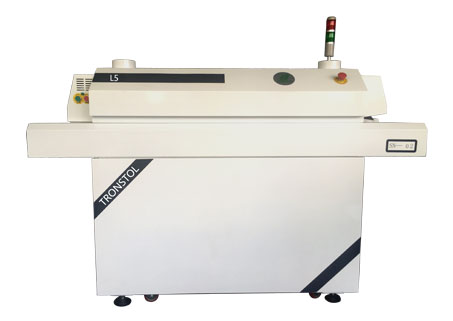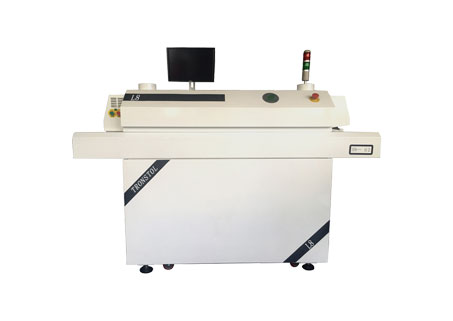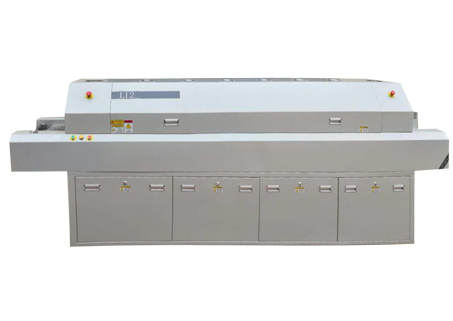86-571-26265158
Reflow soldering technology is widely used in the field of electronic manufacturing. The components on the various boards used in our computers are soldered to the circuit board through this process. This PCB reflow oven machine has a heating circuit inside to heat air or nitrogen. When the temperature is high enough, blow it to the circuit board where the component has been attached, so that the solder on both sides of the component will melt and bond with the motherboard. The advantage of this process is that the temperature is easy to control, oxidation can be avoided during the welding process, and the manufacturing cost is easier to control. Our reflow soldering oven is cheap and the soldering effect is good. It can guarantee the yield of electronic components and greatly improve the efficiency in the processing of electronic components.
As an experienced reflow oven manufacturer in China, we provide different types of surface mount reflow oven (SMD/SMT reflow oven, mini or small reflow oven, etc) that are fit for various temperature zones, you can choose the most suitable one according to your own needs.






Theoretically ideal temperature curve consists of preheating zone, heat preservation zone (active zone), heating zone (reflow zone) and cooling zone. The first three zones are heated, and the last zone is cooled.
①In the preheating zone, heat the board from room temperature to around 150°C. Preheating is to activate the solder paste and to avoid the rapid high temperature heating during the immersion of tin, which will cause defective parts. The goal of this area is to heat the board at room temperature as soon as possible, and the heating rate should be controlled within an appropriate range. If the temperature rises too fast, thermal shock will occur, and the boards and components may be damaged; if the temperature rises too slowly, the solvent will not evaporate adequately and affect the soldering quality.
②Insulation zone (active zone), generally 150°C~180°C, within 200°C. The activity of the solder paste is the strongest in this temperature range, and it is maintained for about 90s. The main purpose of the insulation stage is to stabilize the temperature of the internal components of the reflow oven, and to minimize the temperature difference of each part. Stay in this area for enough time to make the temperature of the larger components catch up with the temperature of the smaller components, and ensure that the flux in the solder paste is fully volatilized. At the end of the insulation stage, the oxides on the bonding pad, solder balls and component pins are removed under the action of the flux, and the temperature of the entire circuit board is also balanced.
③In the heating zone (reflow zone), the solder paste begins to melt and the time is between 60s and 90s. In this area, the heater temperature is set to the highest, so that the internal temperature quickly rises to the peak temperature. The peak temperature of the reflow curve is usually determined by the melting point temperature of the solder paste and the heat-resistant temperature of the boards and components. The peak temperature also varies depending on the solder paste used. Generally, the maximum temperature of lead-free solder paste is 230°C-250°C, and the maximum temperature of lead-containing solder paste is 210°C-230°C. Pay attention to the time in the heating zone not to be too long to prevent damage to the inner wall of the reflow oven, damage to electronic components or scorching of the circuit boards.
④In the cooling zone, quickly reduce the temperature to solidify the solder paste. In this area, the temperature is cooled to below the solid phase temperature to solidify the solder joints. The cooling rate will have an impact on the strength of the solder joints. If the cooling rate is too slow, it will cause excessive eutectic metal compounds to be produced, and a large grain structure will appear at the solder joints, making the strength of the solder joint lower.
Reflow oven is a equipment for soldering components to a PCB board. It relies on the action of hot air flow on the solder joints. The glue-like solder paste undergoes a physical reaction under a certain high temperature air flow to achieve SMD soldering. The reason why it is called "reflow soldering" is that Because the gas circulates in the reflow oven to generate high temperature to achieve the purpose of welding.
1. The local heating method is used to complete the welding task, so the components to be welded have little thermal shock and will not be damaged due to overheating.
2. The welding technology only needs to release the solder at the welding part and heat it locally to complete the welding, thus avoiding welding defects such as bridging.
3. The solder is only used once, and there is no reuse, so the solder is pure and free of impurities, which ensures the quality of the solder joints.
4. It has a self-positioning effect. When the component placement position deviates to a certain extent, due to the surface tension of the molten solder, when all the solder ends or the pins and the corresponding pads are wetted at the same time, they are automatically pulled under the action of surface tension return to approximate target position.
